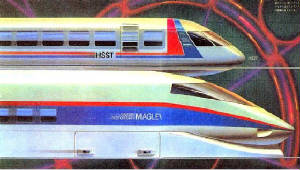|
Skepticism remains.
Even for those who are aware of the urban maglev technology, not many are keen to jump on board right away.
They believe that proven technology means many years of successful operation, and with at least a few, not just one application.
They do not intend to be the leader in adopting technology but would rather take a wait and see attitude.
There are many reasons why magnetically levitated trains could be preferred over conventional
transit systems
• Inter-city transportation: Much higher speeds than are possible
with steel-wheeled trains, lower noise, greater passenger comfort, increased safety against mechanical failures, reduced maintenance.
• Relative to aircraft: Higher energy efficiency, safer, less weather-dependent,
and would permit in-city departure and arrival.
• Urban transit systems: Lower noise, much lower maintenance, greater
rider comfort, can climb steeper grades, higher energy efficiency than conventional urban transit systems.
|
|
 |
 |
 |
|
Flagship Maglev Group.
|
 |
|
Useful Tips
|
 |
|
|
 |
 |
|

Maglev work under the " superconductivity System ". This system repulsive
force between two magnetic fields to push the train away from the rail track and it will conduct electricity even after the
power has been shut off, which would allow the maglev system to run with far less energy.
|
|
|
Fear of new technology .
Lack of technical know how is another area of concern as the clients ( sometimes their consultants
as well ) feel that they would lose control of the project and is at mercy of the supplier to tell them what is good for them.
Despite the advantages of requiring less maintanence, some maintainers feel uncomfortable with new technology as they have
to go through the learning curve again. They feel that maglev is a highly sophisticated technology and it would be difficult
to maintain.
• The advantages of maglev in urban settings (relative to conventional urban rail systems) include:
Lower noise,
lower maintenance, higher efficiency, higher grade and tighter turn capabilities (allowing
operation on elevated tracks that can accommodate to an urban environment
without
the need for underground-tunnel operation).
|
|
 |
|
March 2005 evaluation by the Maglev Technological Practicality Evaluation Committee.
In March 2005, a report by the Ministry of Land, Infrastructure and Transport's Maglev
Technological Practicality Evaluation Committee was extremely positive, confirming that " a viable technology for the Maglev
railway has been established ". We believe that this represents a recognition that the condition for a viable technology have
been met as a result of ongoing Maglev technological development.We shall continue to aim for futher improvements in core
technologies such as superconducting magnet technology towards the final completion of the Maglev rail system.
HSST is in Successful Operation Since early 2005.
The Tobu Kyuryo Line oif Nagoya, Japan commenced revenue service in March 2005. This is the First
Full Scale Commercial application of the urban maglev technology in the world. Ths Tobu Kyuryo Line adopted
the HSST urban maglev technology developed by the Chubu HSST Development Corporation. Coinciding with the World Expo 2005
Nagoya, during its first seven months of operation since 2005, the line was heavily utilized and carried about 20 million
passengers within that period.
|
 |
|
|
|
|
|
